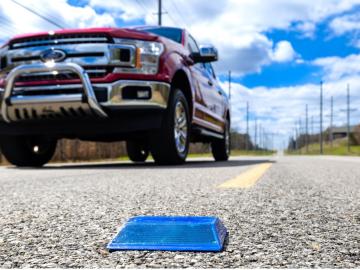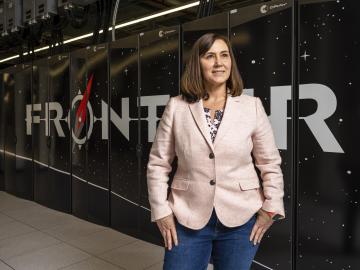
Filter News
Area of Research
- (-) Energy Science (180)
- (-) Supercomputing (59)
- Advanced Manufacturing (22)
- Biology and Environment (30)
- Building Technologies (1)
- Computational Engineering (1)
- Computer Science (6)
- Electricity and Smart Grid (3)
- Fuel Cycle Science and Technology (1)
- Functional Materials for Energy (1)
- Fusion and Fission (30)
- Fusion Energy (10)
- Isotope Development and Production (1)
- Isotopes (27)
- Materials (68)
- Materials for Computing (11)
- National Security (29)
- Neutron Science (16)
- Nuclear Science and Technology (38)
- Nuclear Systems Modeling, Simulation and Validation (1)
- Quantum information Science (1)
- Sensors and Controls (2)
- Transportation Systems (2)
News Topics
- (-) 3-D Printing/Advanced Manufacturing (81)
- (-) Big Data (27)
- (-) Exascale Computing (27)
- (-) Grid (41)
- (-) Isotopes (2)
- (-) Microelectronics (1)
- (-) Nuclear Energy (11)
- (-) Security (10)
- (-) Transportation (70)
- Advanced Reactors (7)
- Artificial Intelligence (42)
- Bioenergy (29)
- Biology (19)
- Biomedical (22)
- Biotechnology (6)
- Buildings (39)
- Chemical Sciences (16)
- Clean Water (8)
- Composites (17)
- Computer Science (108)
- Coronavirus (25)
- Critical Materials (12)
- Cybersecurity (14)
- Energy Storage (74)
- Environment (69)
- Fossil Energy (2)
- Frontier (32)
- Fusion (2)
- High-Performance Computing (44)
- Hydropower (3)
- Machine Learning (20)
- Materials (45)
- Materials Science (40)
- Mathematics (4)
- Mercury (3)
- Microscopy (14)
- Molten Salt (1)
- Nanotechnology (15)
- National Security (11)
- Neutron Science (20)
- Partnerships (12)
- Physics (8)
- Polymers (13)
- Quantum Computing (20)
- Quantum Science (26)
- Simulation (18)
- Software (1)
- Space Exploration (6)
- Statistics (1)
- Summit (44)
Media Contacts

Working with Western Michigan University and other partners, ORNL engineers are placing low-powered sensors in the reflective raised pavement markers that are already used to help drivers identify lanes. Microchips inside the markers transmit information to passing cars about the road shape to help autonomous driving features function even when vehicle cameras or remote laser sensing, called LiDAR, are unreliable because of fog, snow, glare or other obstructions.

To support the development of a revolutionary new open fan engine architecture for the future of flight, GE Aerospace has run simulations using the world’s fastest supercomputer capable of crunching data in excess of exascale speed, or more than a quintillion calculations per second.

Like most scientists, Chengping Chai is not content with the surface of things: He wants to probe beyond to learn what’s really going on. But in his case, he is literally building a map of the world beneath, using seismic and acoustic data that reveal when and where the earth moves.

For more than 100 years, Magotteaux has provided grinding materials and castings for the mining, cement and aggregates industries. The company, based in Belgium, began its international expansion in 1968. Its second international plant has been a critical part of the Pulaski, Tennessee, economy since 1972.

ORNL scientists found that a small tweak created big performance improvements in a type of solid-state battery, a technology considered vital to broader electric vehicle adoption.

Lawrence Livermore National Laboratory’s Lori Diachin will take over as director of the Department of Energy’s Exascale Computing Project on June 1, guiding the successful, multi-institutional high-performance computing effort through its final stages.

At the National Center for Computational Sciences, Ashley Barker enjoys one of the least complicated–sounding job titles at ORNL: section head of operations. But within that seemingly ordinary designation lurks a multitude of demanding roles as she oversees the complete user experience for NCCS computer systems.

Inspired by one of the mysteries of human perception, an ORNL researcher invented a new way to hide sensitive electric grid information from cyberattack: within a constantly changing color palette.

On the grounds of the University of Maine’s Advanced Structures and Composites Center sits the nation’s first additively manufactured home made entirely from biobased materials - BioHome3D.

A trio of new and improved cosmological simulation codes was unveiled in a series of presentations at the annual April Meeting of the American Physical Society in Minneapolis.


